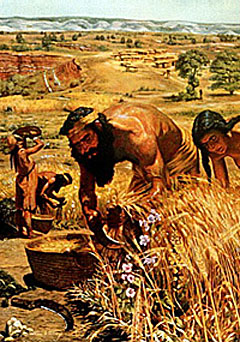 The illustration at left shows the new way of life, at least as practiced in the Near East, where the chief plants exploited were the cereal grains, wheat and barley.
The illustration at left shows the new way of life, at least as practiced in the Near East, where the chief plants exploited were the cereal grains, wheat and barley.It is important to understand that this new way of life meant a whole new set of opportunities for human beings and a whole new set of problems as well.
The following list suggests some of the problems inherent in this new way of life: 1. Dependency on few plants--Agriculture made human communities, like this one pictured at left in Turkey, dependent on relatively few plants--the main crops which they grew--rather than on the many different kinds of plants which hunter-gatherers use.
2. Greater vulnerability to weather--dependency on fewer plants in turn makes agriculture a great gamble, as farming involves "betting" that the weather conditions will favor the growth of the particular crops planted. Weather patterns, however, constantly fluctuate and rainfall tends to vary unpredictably. Hunter-gatherers collect food from a hundred different plant species, some of which flourish in wet weather, some in dry, some are cold-resistant, etc. In such a mode of life, some sources of food are available whatever the weather is like in a particular year. Agricultural life, in contrast, bets the life of the community on weather patterns favorable to the few plants it cultivates. Agriculture thus continues the ancient dependency of human life upon natural, ecological systems like the weather cycle, but it raises the odds of disaster in any given year. Thus, early agriculture tended to be even more vulnerable to changes in the weather than hunting and gathering had been.
3. Complete dependency on harvest times--To survive, agriculturalists have to gather all their food for the year at one or two or three harvest times, rather than gathering year round. Nothing, therefore, can be allowed to interupt the harvest. There is similarly a very narrow window of opportunity for planting and cultivating. Under this kind of pressure, agricultural communities became more time-conscious. Agriculturalists also have to store the produce of their fields for the rest of the year, protect it from moisture, vermin, and thieves, and learn to dole out supplies in measured quantities so the community can survive and have seed for next year's planting. These conditions created a new kind of life style. (Note the contrasting absence in hunting and gathering conditions of incentives to store food or to refrain from consuming whatever is available at the moment, or to plan for the future. The agricultural community that behaves in ways appropriate for hunter-gatherers soon starves to death.)
4. Need for intense physical labor--Agriculture requires intense and sustained physical effort--"drudgery"--at several times of the year, and on a scale previously unknown. In the Near East, cereal-growing required back-breaking labor at both sowing and harvest times. The labor of both men and women was required in the fields. As can readily be imagined, these fundamental conditions of survival encouraged the development of social as well as individual discipline. That is to say, the new way of life molded humans and human society in new ways.
| Previous Page | Next Page | Ag Rev Home |